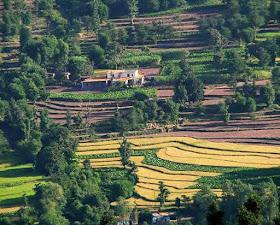 |
| Soil Management |
Tillage, conservation, and cropping practices are soil management techniques that are used to preserve soil resources while optimizing soil use.
Soils are managed differently depending on their intended use. Soil management groups are soil types with similar adaptations or management requirements for specific purposes, such as use with crops or cropping rotations, drainage, fertilization, forestry, highway engineering, and construction.
In managing soil for agriculture, soil management includes all tillage and planting operations, cropping practices, fertilization, liming, irrigation, herbicide and insecticide application, and other treatments conducted on or applied to the soil surface for the production of plants.
  |
Tillage
The most basic aspect of soil management is the way in which it is cultivated or tilled for crop growth. Tillage is the mechanical manipulation of the soil profile to modify soil conditions, manage crop residues or weeds, or incorporate chemicals for crop production. Tillage can be exhaustive or minimal.
Conventional tillage uses multiple tillage operations to bury existing crop residue and prepare a uniform, weed-free seed bed for planting. This method breaks up soil aggregates in the process and destroys soil structure. Consequently, it can result in excessive wind and water erosion.
Conservation tillage, or minimum tillage, involves soil management practices that leave much more crop residue on the soil surface and cause much less soil disruption.
As a result, the soil is less susceptible to erosion, and the plant residue acts as a mulch to protect the soil surface from the destructive impact of rainfall as well as to reduce evaporation.
No-tillage, or chemical tillage, is a soil management practice adapted to sloping soils in which herbicides rather than tillage are used to control weeds, while the disruption of soil structure is limited to a narrow slit in the soil surface in which the seeds are planted.
Hillsides and Wetlands
Soil management extends to the way in which soils are manipulated. Terraces, for example, are raised horizontal strips of earth constructed along the contour of a hill to slow the movement of down-ward-flowing water.
Tile drains are perforated ceramic or plastic pipes buried in poorly drained soils that act as underground channels to carry water away, lower the water table, and allow a soil to drain faster after rainfall.
The benefit of managing potentially erodible soils on hill slopes as permanent pastures is being recognized as another way of managing hillside soils.
Likewise, the value of retaining wet soils as wetlands has been acknowledged. Wetlands provide wild life habitat, assist in flood control, and act as buffers to protect surface waterways from nutrient and soil runoff from cultivated fields.
Chemical Management
Soil management also involves the addition of chemicals to soil: lime to make acid soils more neutral, fertilizers to increase the nutrient level, herbicides and insecticides to control weed and insect pests, soil conditioners to improve soil aggregation, structure, and permeability.
A growing technology is the use of mobile global positioning system (GPS) units attached to the equipment that applies these chemicals to soil.
Called site-specific management, it uses computer technology to regulate chemical addition based on the exact position in a field and previous yield or fertility maps that indicate whether the soil needs to be amended.
The goal of site specific management is to optimize chemical use and profit while minimizing potential chemical loss to other environments by only applying the chemicals to areas where they are needed.